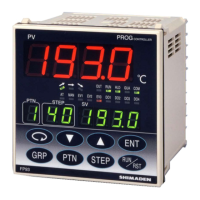is printed. This is to warn you of the risk of
electric shock which may result if the charger is touched while being energized.
z As a means to turn the power off, a switch or a breaker should be installed in the external power circuit to be connected to the power
terminal of the instrument. Fix the switch or the breaker adjacently to the instrument in a position which allows it to be operated
with ease, with an indication that it is a means of turning the power off. Use a switch or a breaker which meets the requirement of
IEC60947.
z Fuse:
Since the instrument does not have a built-in fuse, do not forget to install a fuse in the power circuit to be connected to the power
terminal. A fuse should be positioned between a switch or a breaker and the instrument and mounted on the L side of the power
terminal.
Fuse rating / characteristics: 250V AC 1A / medium lagged or lagged type.
Use a fuse which meets the requirement of IEC60127.
z Voltage / current of a load to be connected to the output terminal and the alarm terminal should be within a rated range.
Otherwise, the temperature will rise to reduce the life of product and/or to result in problems with the product. For rated
voltage/current, see "9. Specifications" of this manual.
The output terminal should be connected with a device which meets the requirements of IEC61010.
z A voltage / current different from that of the input specification should not be applied to the input terminal.
It may reduce the life of the product and/or result in problems with the product. For rated voltage / current, see "9. Specifications" of
this manual.
z In the case of voltage or current input, the input terminal should be connected to a device which meets the requirement of
IEC61010.
The instrument is provided with a draft hole for heat discharge. Take care to prevent metal and other foreign matters from getting
into it. Failure to do so may result in trouble with the instrument or may even cause a fire.
z Don't block the draft hole or allow dust or the like to stick to it. A rise in temperature or insulation failure may result in a reduction
of the life of the product and/or problems with it or may cause a fire.
For spaces between installed instruments, refer to "3-3. External Dimensions and Panel Cutout."
z It should be noted that repeated tolerance tests against voltage, noise, surge, etc. may lead to deterioration of the instrument.
z Users are prohibited from remodeling the product or abnormal use of it.
z It takes 30 minutes to display the correct temperature after applying power to the Program Controller. (Therefore, turn the power on
more than 30 minutes prior to the operation.)

